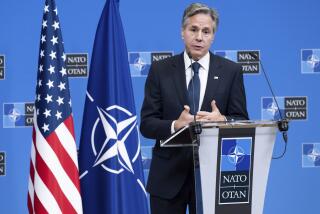What the East Europeans and Soviets Need Now Is Trade Not Billions in Aid : Diplomacy: U.S. should leapfrog the Europeans and Japanese and negotiate free-trade agreements with its former foes.
President Boris N. Yeltsin’s recently announced economic plan of free prices, budget-cutting, privatization and private property represents a turning point in Russian history. In the words of a Moscow wiseacre, “ Perestroika is dead, long live perestroika. “ This emerging era of Russian capitalism also may hold tremendous economic opportunities for the United States.
U.S. policy vis-a-vis the Kremlin has been anything but a smashing success during the last five years. By putting all its eggs in the Mikhail S. Gorbachev basket, by vigorously supporting his pseudo-reforms and by clinging stubbornly to the historical anachronism named “Soviet Union,” Washington may have unwittingly helped delay the old system’s day of reckoning now upon us. This is worth remembering, because today’s “Let’s help them” slogans obscure similarly dubious prescriptions.
The operative word this time is “aid.” Dozens of aid schemes involving billions of dollars are being bandied about, with little thought paid to likely consequences. There is, of course, a moral imperative to provide emergency humanitarian aid to people in dire need, as the Hoover Administration did when it fed 10 million Russians in the 1921-1922 famine. Short of such catastrophes, however, direct aid is often wasted, because the necessary mechanisms for its delivery don’t exist. It can also be counterproductive when used to postpone, rather than promote, reform. The $160 billion in Western credits, soft loans and assorted government handouts sunk in the Soviet Union and Eastern Europe since 1970 are testament to unfruitful aid policies.
The most disturbing part of this policy, at least since the collapse of communism in Eastern Europe, is that it has been used to postpone or avoid the only thing the West can do to help the East effectively--opening its markets according to the old Yankee maxim, “Trade not aid.”
Much aid rhetoric notwithstanding, neither the European Community nor the Japanese have shown any real inclinations to help the struggling Eastern economies by letting in their products. For example, Western Europe, by continuing to protect its inefficient farmers, has thrown up a virtually insurmountable barrier to the quick recovery of Eastern European agriculture. Similar barriers exist for coal, steel, textiles and many other products in which the new democracies are already competitive. Instead, the East is fed vague promises of full Common Market membership sometime in the distant future. Little wonder that for many Eastern Europeans, the Berlin Wall has simply been replaced by a new, if invisible, economic wall on the eastern borders of Germany.
Therein lies the opportunity for the United States to help stimulate economic development in the East, while promoting its own economic and political interests. What Washington could--and should--do is leapfrog the Europeans and Japanese by negotiating free-trade pacts with Eastern European countries, Russia and any of the other ex-Soviet republics that have embarked on radical reforms.
The benefits of such an initiative would cost relatively little, since U.S. markets are largely open already. Politically, this kind of U.S. endorsement and explicit vote of confidence in radical reform would undoubtedly strengthen the pro-democratic market forces currently fighting for public support in the face of severe economic hardship. This would be of particular import in Russia, where, in a nightmare scenario, the failure of Yeltsin’s program could result in the re-emergence of a rabidly xenophobic, blame-the-West fascist regime still in possession of 20,000 nuclear weapons.
The real pay dirt, however, both in the short and longer terms, is in the economic realm. Despite their dismal predicaments, most of East European economies are far from the irredeemable basket cases of conventional wisdom in terms of levels of development, natural resources and, especially, human potential. This is particularly so with Russia, which, with a well-educated population of less than 150 million, has between 30% and 40% of the world’s proven reserves of gas, coal, iron and several rare metals.
These countries, moreover, have tremendous needs precisely in areas where the United States still excels. U.S. oil-extraction technology and know-how, for example, are second to none and could easily secure a dominant position for the United States in exploring for Russian oil. The U.S. economy could also harness some of the sizeable scientific and engineering potential of the East. With the United States currently producing only half the number of engineers that Japan turns out, this could become a critical factor in our future competitiveness.
The prospect for a close and profitable economic association with the former Soviet bloc is made easier by another, less tangible factor. Despite decades of vicious anti-American propaganda, most of the peoples of Eastern Europe and the former Soviet Union retain remarkably strong sympathies for America and its ideals. So much so that the region, as a whole, may be the last great reservoir of pro-American feeling. Given the opportunity, many of them may prefer to do business with us rather than with the Germans and the Japanese.
In pondering the pros and cons of economic integration with our former Cold War adversaries, the United States should also consider its longer-term implications. It may have won the great ideological war with communism, but holding its own in the unfolding economic battle royal is far from certain. Next year will mark the emergence of Western Europe as a single economic entity likely to become more rather than less protectionist. Meanwhile, in Asia, a newly proposed East Asian Economic group looks remarkably like the ill-fated Japanese Asia Co-Prosperity Sphere of World War II. Dominated by Japan, it will include 10 of the fastest-growing economies in the world.
There is thus plenty of concern that America and its open markets may soon be facing large protectionist blocs it is ill-prepared to compete against. Securing a major economic foothold, perhaps even a dominant stake, in the wide-open and potentially huge markets in the East, alongside the promising North American Free Trade Zone currently being negotiated, would give the United States a fair chance to compete successfully. The opportunity is there, but it must be seized by Washington without delay. For, as a Russian politician observed, after hearing Yeltsin’s reform proposals: “The future has arrived.”
More to Read
Sign up for Essential California
The most important California stories and recommendations in your inbox every morning.
You may occasionally receive promotional content from the Los Angeles Times.










